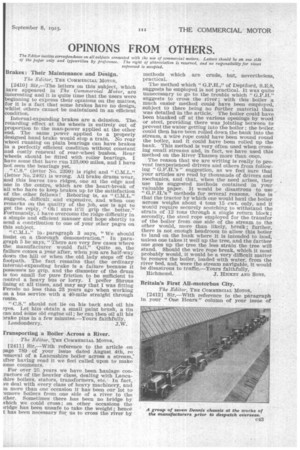rransporting a Boiler Across a River.
Page 27

If you've noticed an error in this article please click here to report it so we can fix it.
The Editor, THE COMMERCIAL MOTOR.
[2411] Sir,—With reference to the article on page 789 of your issue dated August 4th, re removal of a Lancashire boiler across a stream,' Ater having read it we feel called upon to make ;owe comments.
For over 25 years we have been haulage con,ractors of the heavier class, dealing with Lanca:hire boilers, stators, transfortners, etc. In fact, ve deal with every class of heavy machinery, and m more than one occasion it has been our lot to -emove boilers from one side of a river to the )ther. Sometimes there has been no bridge by which we could cross ; on other occasions the ridge has been unsafe to take the weight ; hence t has been necessary for us to cross the river by methods which are crude, but, nevertheless, practical.
The method which " G.P.H.," of Deptford, S.E.8, suggests he employed is not practical. It was quite unnecessary to go to the trouble which " G.P.H." suggests to cross the river ; with this boiler a much easier method could have been employed, subject to there being no further material than was detailed in the article. The boiler could have been blanked off at the various openings by wood or steel, providing there was jointing between to prevent the water getting into the boiler ; the boiler could then have been rolled down the bank into the stream, a wire rope could have been wound round the boiler, and it could have been rolled up the bank. This method is very often used when crossing small streams and, in fact, we have used this method on the River Thames more than once.
The reason that we are writing is really to prevent inexperienced drivers and others from following " G.P.H.'s " suggestion, as we feel sure that your articles are read by thousands of drivers and mechanics, and that, when the need arises, they use the suggested methods contained in your valuable paper. It would be disastrous to use " G,P.H.'s F5 methods for several reasons. One is that the tractor by which one would haul the boiler across weighs about 4 tons 15 cwt. only, and it would require securely scotching to withstand the strain of 12 tons through a single return block ; secondly, the steel rope employed for the transfer of the boiler from one side of the stream to the other would, more than likely, break; further, there is not enough headroom to allow this boiler to land on the bank where it Is intended to land, unless one takes it well up the tree, and the farther one goes up the tree the less strain the tree will stand. Should the wire rope break, which it most probably would, it would be a very difficult matter to remove the boiler, loaded with water, from the river bed, and, were the stream navigable, it would be disastrous to traffic.—Yours faithfully, Richmond. J. HICKEY AND SONS.






























